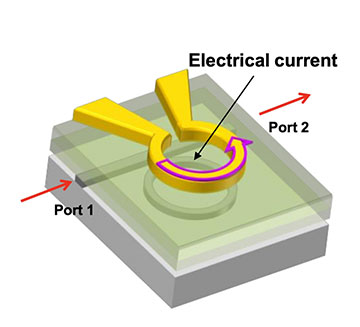
An illustration of electricity flowing through a gold coil and generating electric (purple) and magnetic (faint green) fields. This process changes the properties of the synthetic garnet substrate, which tunes the resonance ring (red) to different frequencies. The setup enables scientists to convert a continuous beam of light (red on left) into pulses that can carry data through a fiber optic cable. [Image: B. Long]
An international team of engineers designed and demonstrated a magneto-optic (MO) modulator that may serve as a template for a fast and efficient data interface for supercomputers in ultracold environments and room-temperature electronics (Nat. Electron., doi: 10.1038/s41928-022-00823-w). The engineers’ MO modulator prototype uses a synthetic garnet and a gold electrode to create a magnetic field that ultimately translates electronic data from a metal wire into photonic data for a fiber optic cable.
“A device like this could enable seamless integration with cutting-edge technologies based on superconductors, for example,” said team co-leader Paolo Pintus, University of California, Santa Barbara, USA, in a press release.
Cool communications
Pairing cryogenic and room-temperature computing systems requires interfaces with high-speed data transfer and minimal heat load. While glass fiber optic cables allow for well-insulated and maximized data transfer, existing modulators that translate electrons from traditional metal wires into photons do not work well at the extremely low temperatures needed for sensitive superconductors and quantum computing systems.
The magneto-optic modulator that consists of gold coil (top), synthetic garnet (green, middle), silicon microring resonator and waveguide (bottom). Port 1 and 2 are the input and output for the optical transmission. [Image: P. Pintus et al., Nat. Electron., doi: 10.1038/s41928-022-00823-w (2022); CC-BY 4.0] [Enlarge image]
The engineers aim to solve this interface problem with a high-speed MO modulator design that operates at temperatures as low as 4 K. Their device includes a layer of synthetic cerium-substituted yttrium iron garnet (Ce:YIG) topped with a circular gold electrode. Below and bonded to the layer of synthetic garnet are a silicon microring and waveguide resonator.
The team chose synthetic garnet for the modulator because it is optically transparent to 1550-nm light—the same wavelength used in fiber optic telecommunications—and gold for the electrode because the metal’s conductivity is enhanced at cryogenic temperatures.
When a stream of electrons from a metal wire hits the gold electrode in the MO modulator, a magnetic field forms that changes the garnet’s refractive index. This “magneto-optic effect” alters the stream of photons traveling through the silicon microring and resonator. The stream of altered photons is an optical translation of the original electron message and leaves the modulator via a fiber optic cable.
Device performance
The engineers conducted proof-of-concept demonstrations of their MO modulator design at cryogenic temperatures in a closed-cycle cryostat. In these experiments, the modulator showed a data rate of up to 2 Gbps with an energy consumption below 4 pJ per bit of transferred information at a temperature of 4 K. While this speed is not fast enough for a practical computing environment, the results are promising, said Pintus.
To improve the efficiency and bit rate of future MO modulator design iterations, the team is developing new materials to replace synthetic garnet, including europium sulfide and europium selenide.

